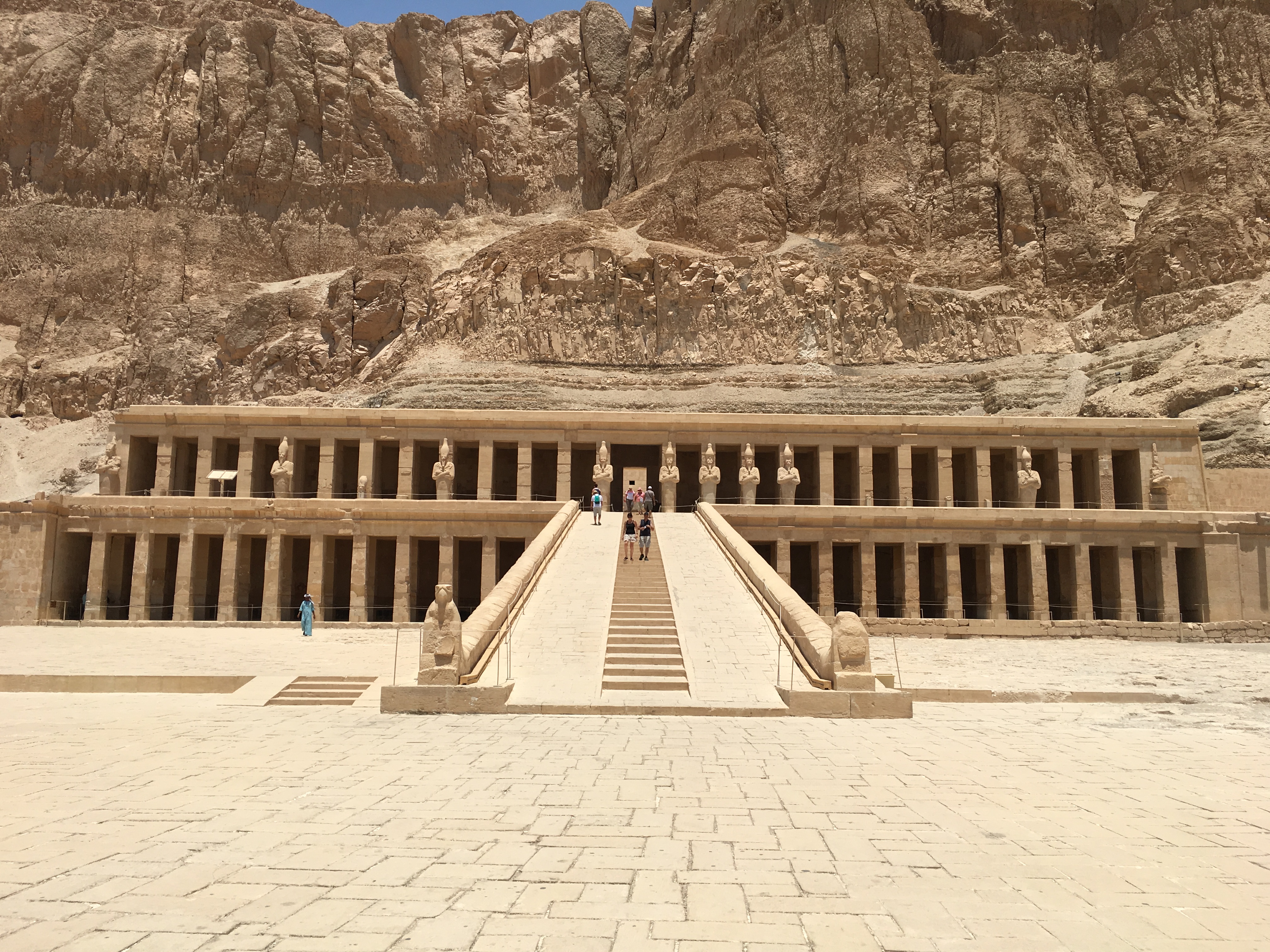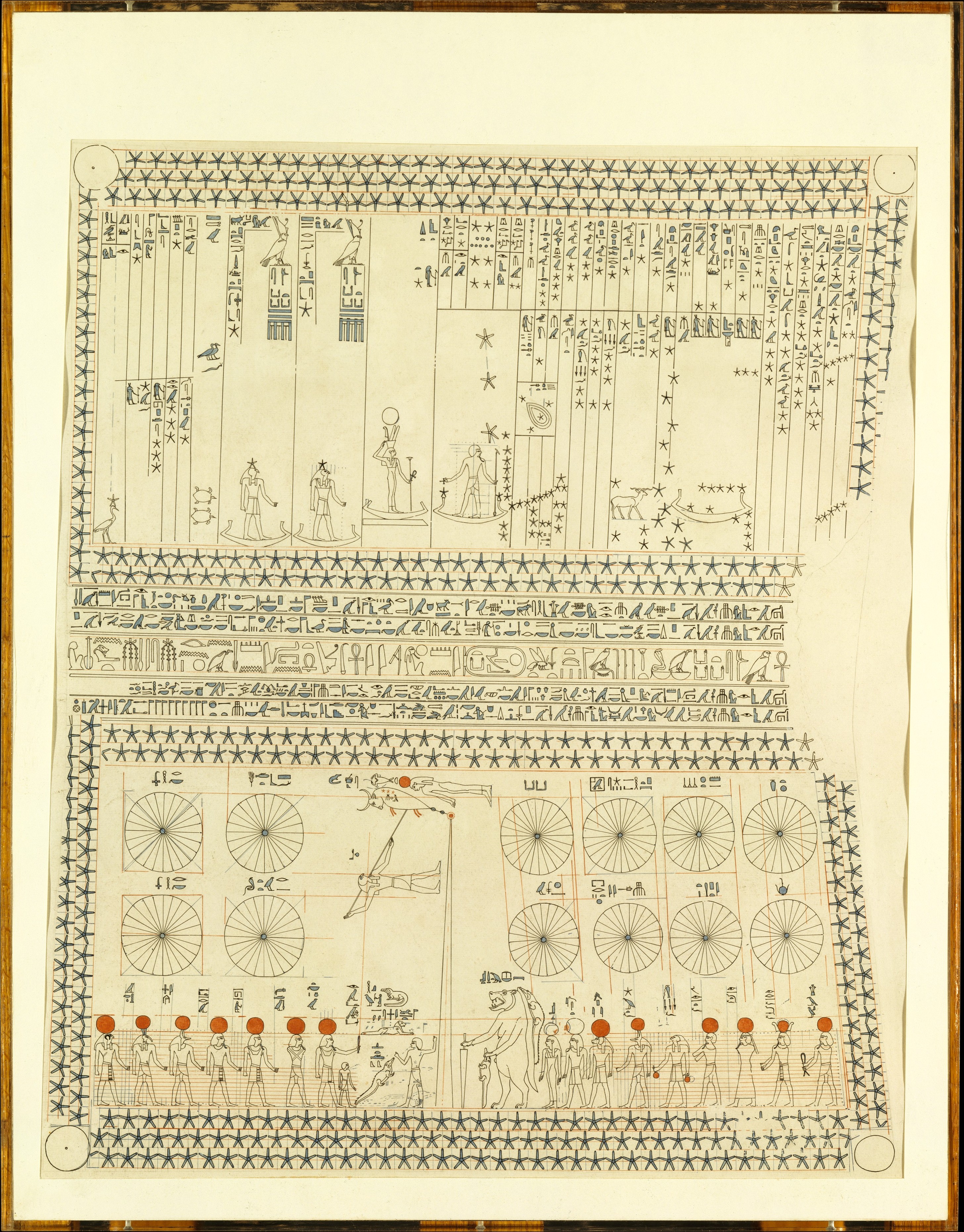|
TT71
Theban Tomb TT71 is located in the Theban Necropolis, on the west bank of the Nile, opposite to Luxor. It was the tomb chapel of Senenmut, who was the steward and architect of Hatshepsut. The chapel is located in the necropolis area around Sheikh Abd el-Qurna. Previously (for about 100 years) the tomb was accessible and for most of this time the target of numerous investigations and intrusions, although early on already heavily destroyed. The tomb was visited already early. In the first half of the nineteenth century, John Gardner Wilkinson, Robert Hay and J. Wild copied scenes, although the decoration was already badly destroyed. Richard Lepsius (1842–45) took the false door to Berlin and copied some inscribed bricks. Only in 1906 Kurt Sethe copied all inscriptions. In 1930–31 Herbert Winlock cleared the whole tomb. Winlock found the fragments of a smashed sarcophagus. Today the tomb chapel's decoration is almost totally gone. With its dimensions it is one of the bigge ... [...More Info...] [...Related Items...] OR: [Wikipedia] [Google] [Baidu] |
Senenmut
Senenmut ( egy, sn-n-mwt, sometimes spelled Senmut, Senemut, or Senmout) was an 18th Dynasty ancient Egyptian architect and government official. His name translates literally as "mother's brother." Family Senenmut was of low commoner birth, born to literate provincial parents, Ramose and Hatnofer (or "Hatnefret") from Iuny (modern Armant). Senenmut is known to have had three brothers (Amenemhet, Minhotep, and Pairy) and two sisters (Ahhotep and Nofrethor). However, only Minhotep is named outside chapel TT71 and tomb TT353, in an inventory on the lid of a chest found in the burial chamber of Ramose and Hatnofer. More information is known about Senenmut than many other non-royal Egyptians because the joint tomb of his parents (the construction of which Senenmut supervised himself) was discovered intact by the Metropolitan Museum in the mid-1930s and preserved. Christine Meyer has offered compelling evidence to show that Senenmut was a bachelor for his entire life: for insta ... [...More Info...] [...Related Items...] OR: [Wikipedia] [Google] [Baidu] |
Minoan Civilization
The Minoan civilization was a Bronze Age Aegean civilization on the island of Crete and other Aegean Islands, whose earliest beginnings were from 3500BC, with the complex urban civilization beginning around 2000BC, and then declining from 1450BC until it ended around 1100BC, during the early Greek Dark Ages, part of a wider bronze age collapse around the Mediterranean. It represents the first advanced civilization in Europe, leaving behind a number of massive building complexes, Minoan art, sophisticated art, and writing systems. Its economy benefited from a network of trade around much of the Mediterranean. The civilization was rediscovered at the beginning of the 20th century through the work of British archaeologist Sir Arthur Evans. The name "Minoan" derives from the mythical Minos, King Minos and was coined by Evans, who identified the site at Knossos with the labyrinth of the Minotaur. The Minoan civilization has been described as the earliest of its kind in Europe, and his ... [...More Info...] [...Related Items...] OR: [Wikipedia] [Google] [Baidu] |
List Of Theban Tombs
The Theban Necropolis is located on the west bank of the Nile, opposite Luxor, in Egypt. As well as the more famous royal tombs located in the Valley of the Kings and the Valley of the Queens, there are numerous other tombs, more commonly referred to as Tombs of the Nobles (Luxor), the burial places of some of the powerful courtiers and persons of the ancient city. There are at least 415 cataloged tombs, designated TT for Theban Tomb. There are other tombs whose position has been lost, or for some other reason do not conform to this classification. See for instance the List of MMA Tombs. Theban tombs tended to have clay funerary cones placed over the entrance of the tomb chapels. During the New Kingdom they were inscribed with the title and name of the tomb owner, sometimes with short prayers. Of the 400 recorded sets of cones, only about 80 come from cataloged tombs. The numbering system was first published Arthur Weigall's 1908 ''Report on the Tombs of Shêkh Abd’ el Gûr ... [...More Info...] [...Related Items...] OR: [Wikipedia] [Google] [Baidu] |
Metropolitan Museum Of Art
The Metropolitan Museum of Art of New York City, colloquially "the Met", is the largest art museum in the Americas. Its permanent collection contains over two million works, divided among 17 curatorial departments. The main building at 1000 Fifth Avenue, along the Museum Mile on the eastern edge of Central Park on Manhattan's Upper East Side, is by area one of the world's largest art museums. The first portion of the approximately building was built in 1880. A much smaller second location, The Cloisters at Fort Tryon Park in Upper Manhattan, contains an extensive collection of art, architecture, and artifacts from medieval Europe. The Metropolitan Museum of Art was founded in 1870 with its mission to bring art and art education to the American people. The museum's permanent collection consists of works of art from classical antiquity and ancient Egypt, paintings, and sculptures from nearly all the European masters, and an extensive collection of America ... [...More Info...] [...Related Items...] OR: [Wikipedia] [Google] [Baidu] |
Astronomical Ceiling Of Senenmut's Tomb
Astronomical ceiling decoration in its earliest form can be traced to the Tomb of Senenmut (Theban tomb no. 353), located at the site of Deir el-Bahri, discovered in Thebes, Upper Egypt. The tomb and the ceiling decorations date back to the XVIII Dynasty of ancient Egypt (circa 1479–1458 BCE). It is closed to the public. Discovery The tomb of Senemut was discovered during the 1925–1927 excavations directed by Herbert Winlock for the Egyptian Expedition of the Metropolitan Museum of Art. The unfinished tomb is entered via a steep descending stairway starting in a quarry. This is 90m long and gives access to three successive chambers under the Mortuary Temple of Hatshepsut. Whether this was done to deliberately place his tomb in the precincts of Hatshepsut's temple or to reach better quality sandstone is not known. The unearthing of the 10x12 ft. chamber known as Chamber A yielded the two panels of what is now referred to as the Egyptian Celestial Diagram. The ceilin ... [...More Info...] [...Related Items...] OR: [Wikipedia] [Google] [Baidu] |
Deir El-Bahri
Deir el-Bahari or Dayr al-Bahri ( ar, الدير البحري, al-Dayr al-Baḥrī, the Monastery of the North) is a complex of mortuary temples and tombs located on the west bank of the Nile, opposite the city of Luxor, Egypt. This is a part of the Theban Necropolis. The first monument built at the site was the mortuary temple of Mentuhotep II of the Eleventh Dynasty. It was constructed during the 21st century BC. During the Eighteenth Dynasty, Amenhotep I and Hatshepsut also built extensively at the site. Mortuary temple of Nebhepetre Mentuhotep Mentuhotep II, the Eleventh Dynasty king who reunited Egypt at the beginning of the Middle Kingdom, built a very unusual funerary complex. His mortuary temple was built on several levels in the great bay at Deir el-Bahari. It was approached by a 16-metre-wide (50-ft) causeway leading from a valley temple which no longer exists. The mortuary temple itself consists of a forecourt and entrance gate, enclosed by walls on three sides, a ... [...More Info...] [...Related Items...] OR: [Wikipedia] [Google] [Baidu] |
Valley Of The Kings
The Valley of the Kings ( ar, وادي الملوك ; Late Coptic: ), also known as the Valley of the Gates of the Kings ( ar, وادي أبوا الملوك ), is a valley in Egypt where, for a period of nearly 500 years from the 16th to 11th century BC, rock-cut tombs were excavated for the pharaohs and powerful nobles of the New Kingdom (the Eighteenth to the Twentieth Dynasties of Ancient Egypt). The valley stands on the west bank of the Nile opposite Thebes (modern Luxor), within the heart of the Theban Necropolis.Siliotti (1997), p.13 The wadi consists of two valleys: the East Valley (where the majority of the royal tombs are situated) and the West Valley (Valley of the Monkeys). With the 2005 discovery of a new chamber and the 2008 discovery of two further tomb entrances, the valley is known to contain 63 tombs and chambers (ranging in size from KV54, a simple pit, to KV5, a complex tomb with over 120 chambers). It was the principal burial place of the major roy ... [...More Info...] [...Related Items...] OR: [Wikipedia] [Google] [Baidu] |
Block Statue (Egyptian)
The block statue is a type of memorial statue that first emerged in the Middle Kingdom of Egypt. The block statue grew in popularity in the New Kingdom and the Third Intermediate Period, and by the Late Period, this type of statue was the most common. These statues were used in temples typically as funerary monuments of non-royal yet important individuals. According to primary sources from the New Kingdom, the posture of the statue was possibly intended to resemble a guardian seated in the gateway of a temple. In addition, their simple shape provided ample flat surfaces for inscriptions of offerings and invocations. Block statues consist of a man squatting with his knees drawn up to his chest and his arms folded on top his knees. Often, these men are wearing a "wide cloak" that reduces the body of the figure to a simple block-like shape. Most of the detail is reserved for the head of the individual being depicted. In some instances the modeling of the limbs has been retained by t ... [...More Info...] [...Related Items...] OR: [Wikipedia] [Google] [Baidu] |
Stelae
A stele ( ),Anglicized plural steles ( ); Greek plural stelai ( ), from Greek language, Greek , ''stēlē''. The Greek plural is written , ''stēlai'', but this is only rarely encountered in English. or occasionally stela (plural ''stelas'' or ''stelæ''), when derived from Latin, is a stone or wooden slab, generally taller than it is wide, erected in the ancient world as a monument. The surface of the stele often has text, ornamentation, or both. These may be inscribed, carved in relief, or painted. Stelae were created for many reasons. Grave stelae were used for funeral, funerary or commemorative purposes. Stelae as slabs of stone would also be used as ancient ancient Greece, Greek and Ancient Rome, Roman government notices or as boundary markers to mark borders or boundary (real estate), property lines. Stelae were occasionally erected as memorials to battles. For example, along with other memorials, there are more than half-a-dozen steles erected on the List of Waterloo Batt ... [...More Info...] [...Related Items...] OR: [Wikipedia] [Google] [Baidu] |
Hathor Frieze
Hathor ( egy, ḥwt-ḥr, lit=House of Horus, grc, Ἁθώρ , cop, ϩⲁⲑⲱⲣ, Meroitic: ) was a major goddess in ancient Egyptian religion who played a wide variety of roles. As a sky deity, she was the mother or consort of the sky god Horus and the sun god Ra, both of whom were connected with kingship, and thus she was the symbolic mother of their earthly representatives, the pharaohs. She was one of several goddesses who acted as the Eye of Ra, Ra's feminine counterpart, and in this form she had a vengeful aspect that protected him from his enemies. Her beneficent side represented music, dance, joy, love, sexuality, and maternal care, and she acted as the consort of several male deities and the mother of their sons. These two aspects of the goddess exemplified the Egyptian conception of femininity. Hathor crossed boundaries between worlds, helping deceased souls in the transition to the afterlife. Hathor was often depicted as a cow, symbolizing her maternal and ... [...More Info...] [...Related Items...] OR: [Wikipedia] [Google] [Baidu] |

.jpg)
.jpg)




